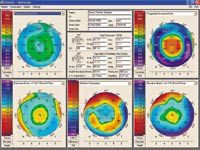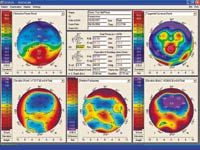Article
Mapping the way to diagnosing ectasia
Houston-Detecting corneal ectatic disorders has become easier because of new technology-such as the Pentacam (Oculus)-that removes artefacts and compensates for asphericity, and various topography and tomography maps that better pinpoint cases of keratoconus, according to Jack T. Holladay, MD, MSEE, FACS.

"A device with topography and tomography is best for detecting corneal thinning disorders, such as keratoconus and pellucid marginal degeneration, because you need both the surface abnormalities as well as the thickness changes," said Dr. Holladay, clinical professor of ophthalmology, Baylor College of Medicine, Houston, and president of the Holladay LASIK Institute, Houston.
The posterior corneal surface is the first and easiest place to detect ectasia because these changes occur first, he explained. The anterior surface changes occur later because the epithelium becomes thinner over the surface of Bowman's membrane, obscuring the protrusion of Bowman's membrane. The instrument used to detect these changes must be accurate, however.
Dr. Holladay described four maps with which ophthalmologists must acquaint themselves to diagnose ectasia correctly. The first, the tangential map, or the local radius of curvature map, looks at radii over the corneal surface as they change and does not reference the radii to the center of the radius of the cornea.

Dr. Holladay's second recommendation was to use a best-fit toric ellipsoid rather than a best-fit sphere, because the cornea is not a sphere.
"An ellipsoid is the closest conic surface that is similar in shape to the cornea," he said. "If the patient has astigmatism and a toric ellipsoid is used, it nicely fits the contour of the cornea."
Newsletter
Don’t miss out—get Ophthalmology Times updates on the latest clinical advancements and expert interviews, straight to your inbox.




